FW Awards 2025 Pig Farmer of the Year finalists
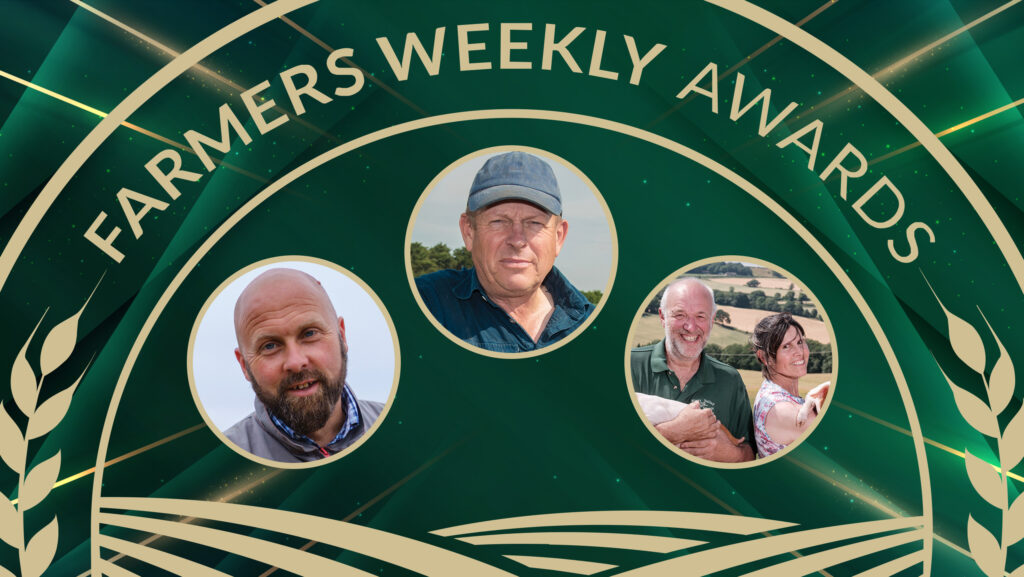
Although their businesses vary greatly, this year’s three finalists share good business sense and a keen eye for detail.
The finalists
- Mike Durrant, Bunns Farm, Norfolk
- Chris Fogden, Bridge Cottage, Suffolk
- Stephen and Karen Thompson, Povey Farm, Derbyshire
The judges
- Katie Jarvis has worked in agricultural policy for several years in the UK and Brussels and is now chief policy adviser for the National Pig Association.
- James Ross was last year’s Pig Farmer of the Year winner. He is a first-generation farmer managing two high-health breeding units in Lincolnshire.
- Charlotte Cunningham is a freelance journalist and former Farmers Weekly deputy livestock editor. She started her career in dairy and now writes across the breadth of the livestock industry.
See also: FW Awards: Meet the 2025 Mixed Farmer of the Year finalists
Mike Durrant, Bunns Farm, Norfolk
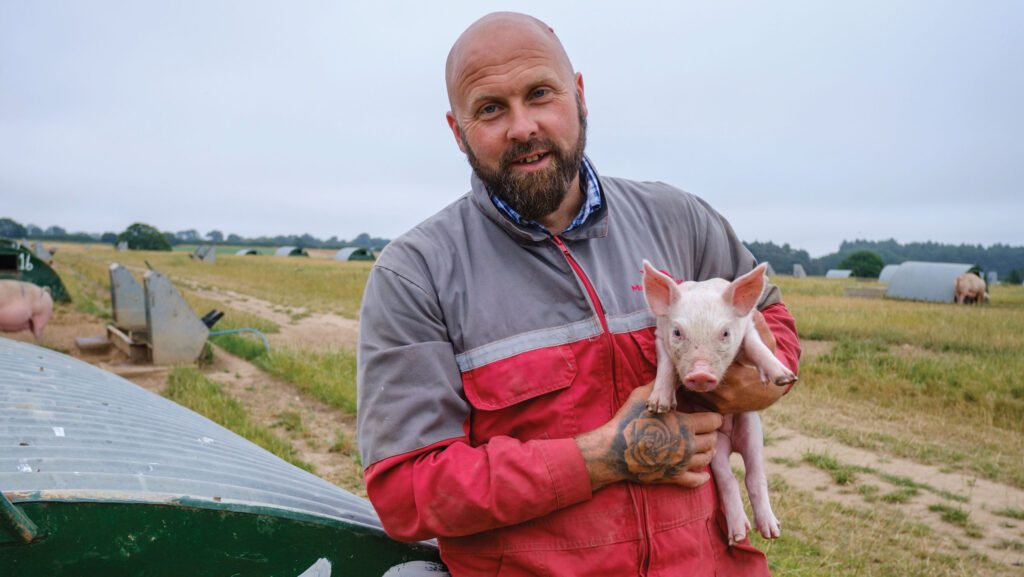
© Jason Bye
Mike Durrant’s journey into pig production began at 16 years of age, after discovering a love for farming – and particularly pigs – inspired by his grandfather, who was fascinated by rural life.
Nearly three decades later, he is running two outdoor breeding herds in Norfolk totalling about 1,700 sows.
Mike worked on a mix of indoor and outdoor units before stepping out on his own. In 2018, he secured his first BQP contract in East Harling and ran the unit for five years.
Determined to return closer to home, he secured a site on the Worstead Estate in North Walsham in 2024.
Over four months, he relocated more than 300 huts and equipment on 90-mile round trips by tractor and trailer.
The old herd was culled and new pigs were settled quickly, with the first farrowings in June 2024 and the first weanings the following month.
More recently, Mike has expanded by taking on an 800-sow unit in west Norfolk under a three-year lease. The two units are run independently of each other to ensure biosecurity.
The system
The larger herd is managed on a five-week, all-in-all-out cycle. Sows are walked through service radials and moved again after seven- and nine-week scans.
Walking rather than trailering reduces soil compaction and keeps animals fitter, says Mike.
Farrowing takes place in insulated outdoor huts, many refurbished by Mike himself at a unit cost of £500, compared with £1,000 or more when bought new.
Farrowing is always staffed in pairs for safety and welfare.
Feeding is done using a quad bike or UTV and small trailers, rather than tractors, saving fuel and minimising soil impact.
A comprehensive vaccination protocol is in place and antibiotics usage is minimal.
Innovation
Mike is trialling ad-lib farrowing feeders to improve sow intake. A simple but effective sprinkler network supplies wallows on dry sow and service fields, saving tanker journeys, fuel and labour.
Shade structures installed this year have helped tackle summer heat and minimise discomfort and stress in the herd.
To protect soils, each site is surveyed before pigs arrive; buffer strips and pollinator crops are sown, and grass cover is maintained wherever possible.
This is done to deliver environmental benefits and to help make the farm “a nice place, visually”, for both the staff and the surrounding village.
Muck and straw are recycled within the estate. Mike has also worked with The Rivers Trust to assess water flows and reduce risk to nearby rivers and broads.
The Worstead team numbers six, many from non-farming backgrounds. All staff complete standard operating procedures for injections and euthanasia, manual handling and first aid.
The new site employs a further four, including a long-standing manager with almost 20 years’ experience.
Flexibility underpins staff management, with hours and rotas adjusted around family life.
Retention is high and younger recruits are given responsibility immediately to help create a feeling of belonging.
The future
Having paid off his first unit in just five years, Mike has shown financial resilience as well as technical ability. His focus now is on consolidating herd performance and refining efficiencies within both herds.
With consistent technical results, strong environmental safeguards and a people-focused culture, he is proving how outdoor pig farming can thrive in today’s industry.
The numbers
- 9.5kg average weaning weight
- 29 pigs weaned a sow a year
- 2.3 litters a sow a year
- 14.1 pigs born alive a litter
- 12.7 weaned pigs a litter
Farm facts
- 1,700 sows across two outdoor units in Norfolk
- Operating a five-week, all-in-all-out weaning system on both units, producing weaned pigs for BQP
- Using Landrace cross Duroc cross Large White genetics
- Red Tractor and RSPCA assured
- 10 staff in total, with six at the main site and four at the second
The judges liked
- Strong technical performance and use of practical innovations such as ad-lib feeders, sprinkler networks and shade systems
- Clear focus on soil health and use of buffer strips and pollinator crops
- A refreshing commitment to staff training and retention, developing new entrants into skilled stockpeople
What the judges say
Mike puts pigs and people at the forefront of all decision making and his business is reaping the rewards of the investment he makes – with sound business metrics shining through.
Chris Fogden, Bridge Cottage, Suffolk
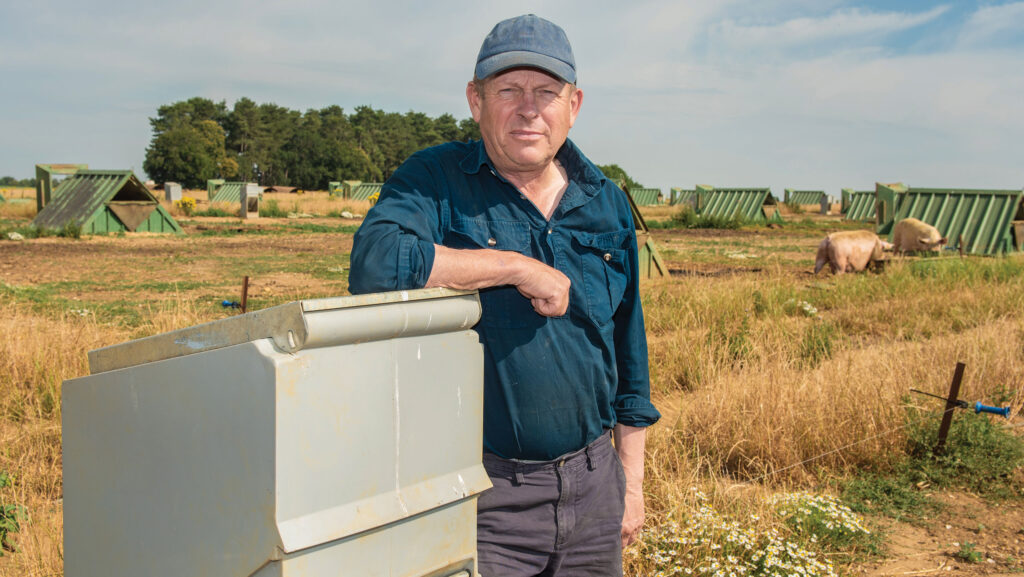
© Phil Weedon
Despite humble beginnings, which started with just 60 sows on 3ha in the late 1980s, Chris Fogden has built and rebuilt an outdoor pig enterprise through multiple market shocks.
After the 2021 rollover crisis forced a rapid downsizing from 1,250 sows and a switch to temporary free-range finishing, he re-engineered the business in late 2022 as a contract-breeding unit with Ian Mosey Livestock.
Today, he runs 1,200 sows on a fortnightly batch system with five-week weaning and a focus on consistent weaning weights, low antibiotics use and labour-efficient routines.
The system
Weaning takes place every other Wednesday. Piglets are shut in, sexed and vaccinated against porcine circovirus type 2, Lawsonia and Mycoplasma hyopneumoniae in the loading tent, then transported to finishing farms.
Sows remain in farrowing paddocks on ad-lib feed, are walked – not trailered – to bulk pens, vaccinated, and then transferred to the service radial.
Serving takes place on a Monday and Tuesday with a three- to four-person crew.
Chris deliberately steps back from the pit to let the team work calmly and methodically.
Farrowing is outdoors in large, insulated huts – a mix of Armadillos, Aardvarks and very large Mosey-made huts.
Using bigger huts has reduced overlays and improved piglet survival, and the smaller huts are being pensioned off.
Investment in 81 new huts will complete the upgrade, helped by a Farming Equipment and Technology Fund grant.
Chris uses Topigs Norsvin genetics (via JSR/Cranswick) and reports very quiet, docile sows that handle well, aiding staff safety and retention.
Feed is supplied by Mosey’s mill and includes high-specification lactation diets, while dry sows receive a dual-purpose specification.
Herd health includes a robust vaccination programme and antibiotics use is limited to occasional, individual treatments.
Innovation
A key innovation is the paddock ad-lib ration feeder with hand-metered ramp-up.
Staff step sows’ feed up by about 0.5kg/day before switching to ad-lib at day six (day four or five in very cold spells; day seven in hot weather).
Notes including farrowing day, feed steps and suckled numbers are written under the feeder lid for quick checks.
This strategy has halved fuel use and tractor hours by eliminating daily auger/feeder trailer rounds.
Three farrowing staff now split batches and walk their own lines instead of following a tractor.
A deliberately flat structure underpins staff retention and performance.
The team is made up of three full-timers plus one part-time person, on 7am-3pm shifts, with one weekend off in three.
Each stockperson “owns” a batch before, during and after farrowing and performance is tracked by batch.
Chris – a Nuffield scholar – puts a lot of store by knowledge exchange within the agricultural community, swapping ideas and experiences via various groups to help further improve production and management techniques.
The future
Resilience defines this business: after contract collapses and a bruising market period, Chris redesigned the model around animal flow, staff ownership, and simple kit that cuts fuel and lifts consistency – while pushing outdoor performance towards indoor benchmarks.
Chris’s priority is on rebuilding reserves after his pension pot took a hit during the tough years.
He is also focused on consolidating fortnightly batching and consistently hitting 14 pigs weaned a litter while pushing outdoor performance closer to indoor benchmarks.
The numbers
- 9kg average weaning weight
- 29 pigs weaned a sow a year
- 2.1 litters a sow a year
- 15 pigs born alive a litter
- 14 weaned pigs a litter
Farm facts
- 1,200 sows on an outdoor breeding unit in Suffolk
- Operating a two-week batching, five-week weaning system producing weaned pigs for Ian Mosey Livestock
- Using Topigs Norsvin genetics
- Red Tractor and RSPCA assured
- Three full-time and one part-time long-term staff members
The judges liked
- Tenacity and resilience to keep building the business despite multiple challenges
- Good use of technology to drive herd performance and reduce the environmental impact of the business
- Giving the team ownership of their own batches to drive standards and deliver very good outputs
What the judges say
Chris has shown determination in the face of adversity, and as such has been able to build up a profitable, sustainable pig business, which is continually achieving good results.
Stephen and Karen Thompson
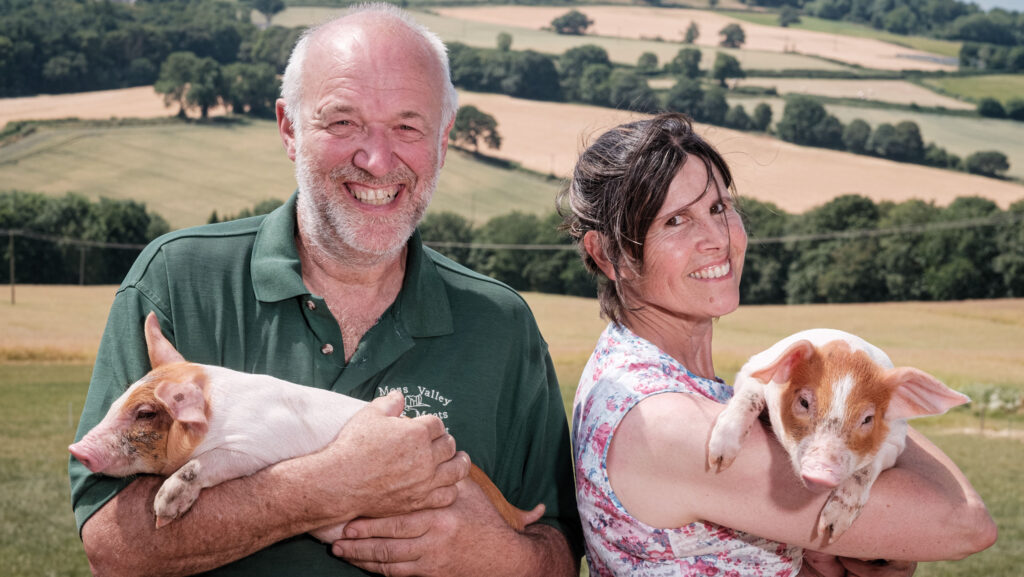
© Jim Varney
Stephen and Karen Thompson have built a pig enterprise that balances precision indoors with strong market links outside the farmgate.
Running a disciplined, three-week batch system on their Derbyshire farm, they achieve technical results that rival much larger units.
Karen and Stephen have added value through butchery and direct marketing.
About one-fifth of the pigs are sold through the family’s award-winning butchery, which supplies 60-70 local restaurants, cafés and delis, as well as farmers’ markets.
All pork carries the prestigious Made in Sheffield mark – the only pig business with this certification – which guarantees provenance and supports premium pricing.
The remaining pigs are sold to Cranswick Preston, giving the family a valuable spread of markets and resilience in volatile times.
The system
Karen’s target for the 200-sow breeding herd is to serve 28-29 sows a batch, and farrow 25 of them consistently every cycle.
This discipline underpins efficiency across the system, ensuring optimal pig flows through the finishing sheds and butchery.
Farrowing performance is strong, with an average of 15.04 piglets born alive a litter.
Careful management of small piglets – including foster systems and supplementary feeding – helps optimise weaning numbers.
Genetics are based on Rattlerow Landrace cross Large White sows, crossed to Danish Duroc terminal sires to maximise growing pig performance and intramuscular fat for butchery demand.
Gilt replacements are home-bred, with seven to eight gilts picked for each batch.
Innovation
Karen is passionate about nutrition and fine-tunes ration formulations using the farm’s mobile mixing system.
All dry sow diets are compound-fed, but lactation, weaner, grower and finisher rations are mixed on farm, using their own cereals supplemented with soya and other straights. Rye is included for gut health.
Increasing calcium, phosphorus and vitamin D in finisher diets has reduced lameness in fast-growing boars.
Average daily liveweight gain is strong, at 800-860g from birth to slaughter, with pigs marketed at 110-115kg deadweight.
Karen is also trialling a range of supplements to support piglet gut health.
Health is tightly controlled through a closed herd policy, stringent biosecurity, and a comprehensive vaccination programme.
The farm vaccinates against atrophic rhinitis, porcine circovirus type 2, ileitis, parvovirus and E coli/rotavirus.
Antibiotics use is low, with non-steroidal anti-inflammatories often used as first-line treatment for all pigs.
The future
A £400,000 redevelopment project is in the pipeline, which will see old gilt accommodation demolished and replaced with a purpose-built gestating sow and gilt shed.
This will feature electronic precision feeders, slatted floors with slurry storage, and high levels of insulation with misting systems for summer cooling – all designed to reduce labour, improve resilience, and future-proof the business.
The project also supports succession, as Karen and Stephen look to step back gradually while son Oliver takes on more responsibility.
Environmental improvements are also part of the long-term plan.
The farm already runs two wind turbines, 60kW of solar panels and 120kW of battery storage, alongside a straw- and woodchip-fuelled biomass boiler.
Work is under way to explore slurry heat exchange for farrowing accommodation, and more arable land is being rented for pig feed self-sufficiency.
The numbers
- 8kg average weaning weight
- 30 pigs weaned a sow a year
- 2.3 litters a sow a year
- 15.04 pigs born alive a litter
- 13.5 weaned pigs a litter
Farm facts
- 200 sows on a birth-to-bacon unit
- Producing pigs for their own butchery, with the remainder going to Cranswick
- Using Rattlerow Large White and Landrace genetics with a Danish Duroc terminal sire
- Red Tractor assured
- One full-time member of staff, plus two part-time and three butchers
The judges liked
- Innovative approach to marketing pigs, which has increased overall business sustainability
- Strong environmental credentials and evidence of expanding this in the future
- Karen’s passion for pig health, using all the tools in the toolbox before turning to antibiotics
What the judges say
Karen and Stephen have built up a thriving business, which balances profitability and performance with environmental protection and sustainability. They highlight the endless opportunity in producing British pigs.
A word from our sponsor
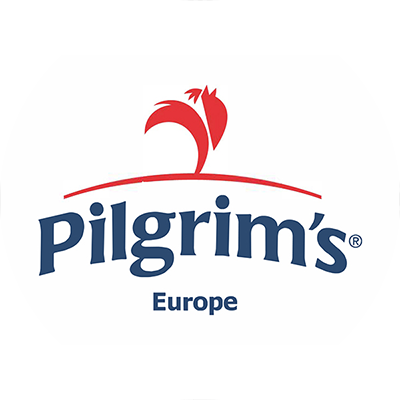
“As the UK’s number-one higher-welfare pig farmer, we are delighted to sponsor the Pig Farmer of the Year award. Congratulations to this year’s finalists – all of whom are shining advocates for the British pig industry.”
Fábio Brancher, operations director, agriculture, Pilgrim’s Europe

